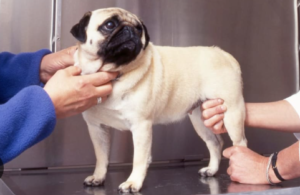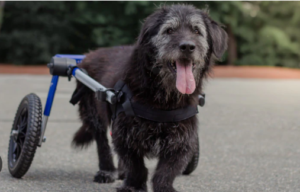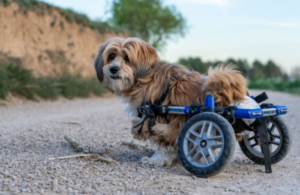As dogs age, their hind legs often weaken due to conditions like arthritis, muscle atrophy, hip dysplasia, or degenerative myelopathy. Weak hind legs can lead to difficulty walking, standing, and overall mobility issues, affecting your senior dog’s quality of life.
If you’re wondering how to strengthen an old dog’s hind legs, you’ve come to the right place. This guide covers causes, symptoms, exercises, diet, treatments, and home remedies to help your furry friend regain strength, mobility, and comfort.
Why Do Senior Dogs Experience Hind Leg Weakness?

Several factors contribute to hind leg weakness in older dogs. Identifying the root cause is crucial to choosing the best treatment.
You may love this one: Can My Pet See in the Dark?
1. Arthritis & Joint Degeneration
Osteoarthritis is common in senior dogs and results in joint inflammation, pain, and stiffness. Over time, dogs use their hind legs less due to discomfort, leading to muscle loss.
2. Muscle Atrophy
As dogs age, their muscle mass naturally decreases. Without regular exercise, their hind legs may become weak, leading to instability and difficulty in movement.
3. Hip Dysplasia
This genetic condition occurs when the hip joint doesn’t fit properly into the socket, causing discomfort, limping, and eventually hind leg weakness.
4. Degenerative Myelopathy (DM)
This progressive spinal cord disease affects mobility, leading to gradual loss of coordination and leg strength. While there is no cure, physical therapy can slow down its progression.
5. Neurological Disorders
Conditions like intervertebral disc disease (IVDD) or spinal injuries can impact nerve function, causing weakness or paralysis in the hind legs.
6. Obesity
Excess weight puts extra strain on a dog’s joints, increasing the risk of arthritis and muscle weakness.
7. Poor Nutrition
A lack of essential nutrients like omega-3 fatty acids, glucosamine, and protein can accelerate muscle deterioration and joint issues.
Signs Your Dog’s Hind Legs Are Weakening

Physical Symptoms
✔ Difficulty standing up or sitting down
✔ Wobbly or unsteady gait
✔ Dragging back legs while walking
✔ Reluctance to climb stairs or jump
✔ Sudden loss of balance or frequent falls
✔ Visible muscle loss in hind legs
Behavioral Changes
✔ Increased lethargy and reduced activity
✔ Whining or showing signs of pain when moving
✔ Avoiding long walks or playtime
If your dog exhibits these signs, consult a veterinarian for a proper diagnosis before starting any treatment or exercise routine.
How to Strengthen an Old Dog’s Hind Legs: Proven Methods

1. Low-Impact Exercises to Rebuild Strength
Regular, gentle exercises can improve mobility, muscle tone, and overall strength.
🚶 Short, Controlled Walks
- Start with 5-10 minute walks on even surfaces.
- Gradually increase the duration as your dog builds strength.
- Avoid hard surfaces like concrete—grass or soft ground is better for joints.
🏊 Hydrotherapy (Water Therapy)
- Swimming reduces pressure on joints while allowing full movement.
- Underwater treadmills at rehabilitation centers help strengthen hind legs safely.
- Always supervise water therapy and ensure your dog feels comfortable.
🛷 Assisted Standing & Sit-to-Stand Exercises
- Gently support your dog’s hips and encourage standing for short periods.
- Guide them into slow, controlled sitting and standing repetitions to engage hind-leg muscles.
🏋 Resistance Band Therapy
- Vets or canine therapists may recommend resistance bands to add light strength training.
2. Proper Nutrition & Supplements for Stronger Legs
A nutrient-rich diet is essential for muscle maintenance and joint health.
🍖 High-Quality Protein
- Supports muscle regeneration and prevents atrophy.
- Best sources: Lean meats, fish, eggs, and high-protein dog food.
💊 Joint Supplements
- Glucosamine & Chondroitin: Reduce inflammation and lubricate joints.
- Omega-3 Fatty Acids (Fish Oil): Help with mobility and reduce stiffness.
- MSM (Methylsulfonylmethane): Improves joint flexibility and recovery.
🦴 Bone Broth
Rich in collagen and amino acids that support joint health and muscle recovery.
💧 Hydration
- Proper water intake keeps muscles flexible and prevents stiffness.
3. Home Adjustments to Support Mobility
Creating a safe and comfortable environment helps prevent injuries and encourages movement.
🛏 Orthopedic Dog Beds
- Provides joint support and reduces pressure on weak hind legs.
📏 Ramps & Stair Alternatives
- Install pet ramps for beds, couches, or cars to reduce strain.
- Avoid slippery floors—use rugs or traction mats for better grip.
🐾 Paw Grip Socks or Boots
- Prevent slipping on hardwood floors, improving confidence in movement.
🦺 Harness & Support Slings
- A rear-lift harness assists dogs who struggle to stand or walk.
4. Veterinary Treatments & Therapies
🏥 Physical Therapy & Rehabilitation
- Veterinary rehabilitation centers offer customized therapy programs.
🩺 Laser Therapy & Acupuncture
- Helps reduce pain, inflammation, and improve nerve function.
💉 Medications (If Needed)
- Anti-inflammatory drugs (NSAIDs) may be prescribed for arthritis.
- Always consult your vet before giving any medication.
Final Thoughts: Helping Your Senior Dog Stay Active & Happy
Aging is natural, but hind-leg weakness doesn’t have to mean the end of mobility. With proper exercise, a balanced diet, supportive home adjustments, and veterinary care, you can help your senior dog regain strength and enjoy a comfortable, active life.
Take Action Today!
✔ Start gentle exercises like short walks or hydrotherapy.
✔ Add joint-supporting supplements to their diet.
✔ Make home modifications to enhance mobility.
✔ Schedule regular vet check-ups for personalized treatment.
Your dog’s golden years can still be active and fulfilling! 🐶💙
FAQs – Strengthening an Old Dog’s Hind Legs
1. Can an old dog regain strength in their hind legs?
Yes! With consistent exercise, proper nutrition, and supportive care, dogs can rebuild muscle strength and mobility over time.
2. How long does it take to see improvement?
It depends on the dog’s condition, age, and treatment. Some dogs improve in weeks, while others may take months of consistent therapy.
3. When should I consult a vet?
If your dog’s weakness worsens, they experience pain, or struggle with basic movement, a vet visit is essential to rule out serious conditions.
